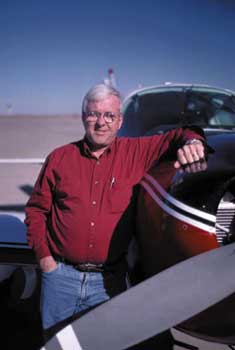|
|

| Wischful Thinking |
| Lifecycle |

by Jay Wischkaemper
Life is a cycle. We are born. We serve our purpose. We die. It happens with people. It happens with plants. It happens with animals. It happens with airplanes.
Automobile junkyards are everywhere. They have to be, because of all the wrecks that occur and because of how quickly cars wear out. Airplane junkyards are less common, and less noticed. They exist, because there is a need for them. You can scour the pages of Trade-a-plane and find where they are, but generally they are hidden from view. That’s as it should be. An airplane is more than a piece of machinery to be junked when its usefulness and financial viability have ended. It is creation born in the mind of man that does something that is unnatural for man to do. It is a creation that demands respect. You don’t use a worn out flag as a dishtowel. You retire it with respect. That’s how an airplane should be retired.
They sit in a most ignominious place. A junkyard filled with rusting hulks of trucks and tractors and farm machinery next to I-40 east of Amarillo also holds three L-1011’s. Once proud, they now sit like rotting carcasses half eaten by vultures. Their bright red paint, the color of LTU Airlines, has turned pink from summers of neglect. The engines have long since been removed, and on two of them, the tail section rests on the ground, having been severed from the fuselage of the plane. No doubt the interior is bare. Seats that carried passengers for years from the airline’s home in Germany to Miami and Orlando and Los Angeles and Toronto sit somewhere hoping for a buyer. Galleys have been removed. Control cables have been severed. Every part that could be salvaged has been dismantled and catalogued. Their only value now is the scrap aluminum, and they sit, waiting for their ultimate end like the condemned prisoner waiting for the executioner.
The junkyard is a couple of miles from the airport where the planes were flown to meet their fate. Amarillo has become, over the years, a small storage, refurbishment, and dismantling facility. It’s not as big as Mojave or Marana, but just as effective. Across the field, housed in an old B-52 hangar, is a facility where, over the years, I’ve watched several retired airliners be converted into beer cans. It’s sad, but it happens. But the Lockheeds are different. Instead of enduring the normal fate of a retired airplane, they sit mercilessly in front of a gaping public; their once proud form now a crippled, helpless shell of its former self.
For years they plied the sky, eager passengers occupying their seats. For years they faithfully generated revenue for their owners. Then, one day a decision was made. They had served their purpose. One day, after unloading their passengers at the gate, the fuel tanks were not refilled, and the galley was not restocked. There would be only one more flight, and that would be the last one. Who knows why? Too many hours. Too many cycles. An AD check due that would cost more than the planes were worth. The lease was up and no one else could be found to operate airplanes this old. For whatever reason, enough fuel was loaded to get to Amarillo. They were taxied to the storage parking area. The ferry crews shut down the engines. As he rose from his seat that one final time, I hope the pilot patted her on the instrument panel and said, "Well old girl, you’ve done a good job, but it’s over." The end had come.
As I see the silhouettes that once proudly flew the Atlantic standing out against the eastern horizon like some sort of side show curiosity, I wonder what people think as they pass by. Perhaps they think nothing, except to wonder about the oddity of three gigantic airliners sitting in a junkyard next to an interstate highway. But if they are airplane people, I’m sure that they, like me, feel a tinge of sadness to see such proud and noble machines come so such a humiliating end.
These three will never fly again. Perhaps some of their donated parts will keep one of the remainder of the fleet going a little longer. They made their contribution. They lived. They served. They died. As my eyes are drawn upward from their final resting place, I see a contrail stretching across the sky being led by that pinpoint of silver barely visible at the front of the ribbon of white. Such is the cycle of life.
Texas native Jay Wischkaemper is a long-time partner in a Bellanca Super Viking, based in Lubbock, which he uses for both his life insurance business and for pleasure. Jay and his wife Dianna have two grown children, Jeff and Lisa, and will celebrate their 30th wedding anniversary this year. |
Click here to return to the beginning of this article.  |
|